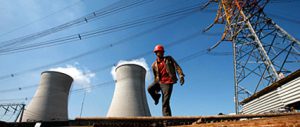While emerging economies of the world are hungry for inexpensive sources of energy, coal use is stable – if not slowly diminishing – in the United States, while US emission standards for fossil fuels are growing more stringent. Unfazed by new regulations, the coal industry now sees a golden future in expanding American coal mining, and exporting the coal to fast growing Asian markets.
Coal export terminals are slated for construction in the states of Washington and Oregon, on the west coast of the United States. If built, they will make America the world’s third largest coal exporter. As those terminals begin operating, the coal exported will effectively cancel out the progressive benefits of new energy policies especially in adjacent states.
In an unusual expression of concern over the planned terminals, nearby California has adopted a resolution – AJR 35 – which says: “This measure urges the President of the United States and the 112th Congress to enact legislation to restrict the waterborne export transshipment of coal for electricity generation to any nation that fails to adopt rules and regulations on the emissions of greenhouse gases and airborne hazardous air pollutants that are at least as restrictive as those adopted by the United States.”
California’s concern is not without cause. With the exception of the young renewable-energy industry, coal is the world’s fastest growing energy source. Worldwide, coal use has grown an average of 4.4% per year since 1990. In recent years, the growth rate of coal consumption has vastly increased. In 2003, the World Coal Institute projected world consumption would reach 7 billion tons by 2030. Just eight years later, in 2011, the figure was almost 7.5 billion tons.
The fastest growing markets are in Asia. In the last three years alone, South Korea’s coal imports have grown by 30% and China’s by a massive 313%. In less than 10 years, China has gone from being a net exporter of coal to the world’s largest coal importer and consumer. With estimated imports of 190-million tons per year and its own production of 3.47 billion tons, in 2011 China accounted for 48% of the world’s coal consumption.
Political support for coal
Six years ago, in lieu of a comprehensive national energy policy, the State of California created its own policy, crafted in the state legislature with bipartisan support and signed into law by then governor Arnold Schwarzenegger. With the signing of the California Global Warming Solution Act of 2006, California embarked on an ambitious plan to increase the state’s energy efficiency and reduce its greenhouse-gas emissions. The goal it set was to reduce greenhouse-gas emissions to 1990 levels by 2020, regardless of population growth and increased demand for energy. As a state ranked as seventh most powerful economy in the world, both the California’s public and private sectors had long been aware of air pollution and the environmental threat presented by the release of greenhouse gases, particularly carbon dioxide, from its power plants, factories, cars and homes.
One component of California’s plan targeted coal-fired power plants as a major cause of airborne pollutants. While California has almost no coal-fired power plants within state borders, it does buy electricity generated by coal from other states. So, California’s Public Utilities Commission created a standard for coal-fired plants of a maximum of 1,100 pounds of carbon-dioxide emissions per megawatt hour. After the termination of existing contracts, electricity from power plants exceeding the standard was banned. The work of California in cooperation with the state’s electric utilities set a valuable standard for the entire United States, and blazed a trail for other states to follow.
But without national guidelines governing energy exports, circumventing energy policies such as California’s is easy. America’s major coal-producing states have small populations and the coal industry makes generous political contributions. Gaining support for coal exports is a simple matter. The coalfields of major coal-producing states such as Wyoming and Montana are on public lands already leased to the coal industry. The lease fees equal approximately one dollar per ton for extracted coal. A sufficient rail system for transport of coal to the export terminals already exists. All that is needed is to build the export terminals themselves, and then coal can be exported to countries where California, or any other US state, has no control over emission standards.
Applications for permits-to-operate four new coal export terminals are on file with the US Army Corps of Engineers. Two additional terminals are under consideration. The four terminals by themselves will export more than 150% of the coal that the entire United States exports today.
To reach the proposed capacity of the new terminals, the coal industry is prepared to increase production in the United States by at least 100 million tons a year. Actively working to increase American coal production and stimulate worldwide coal use are companies like Peabody Energy, the major player in the largest of the planned coal terminals – the Gateway Pacific Terminal – in Bellingham, Washington. Peabody is the largest private coal company in the world, with holdings in the United States, Australia and Asia. Not only does Peabody plan to export US coal to China, it is also a major player in the development of new coalfields in western China’s Xinjiang autonomous region.
Cancelling out emissions savings
While both the United States and China, as the world’s two largest coal users, have begun to institute significant energy-efficiency standards and stringent greenhouse-gas regulations, the unspoken reality is that burning more coal in power plants and steel mills will continue to release more carbon dioxide. Simple mathematics suggests that ever increasing coal use will overwhelm even the best and most rigorous regulation. With California as an example, and taking an average of the carbon emissions projected in a staff paper produced by the California Energy Commission, the coal shipped from the proposed new terminals will add 250 millions tons of greenhouse gases a year to the earth’s atmosphere. The number is five times greater than the quantity of greenhouse gases California has fought to reduce from out-of-state coal-fired power plants.
As coal is mined and burned at an accelerating pace, the conflict between demand for cheap, reliable energy and the environment grows more acute. Carbon dioxide has no respect for international borders, and when the coal shipped by the planned west-coast terminals is burned, that coal will number among the world’s top 25 emitters of carbon dioxide.
Charles West is an American journalist and TV producer with a strong interest in the politics of energy. He lives in Washington state.
Homepage image by coalswam



